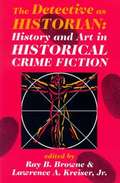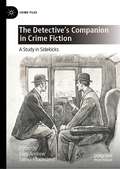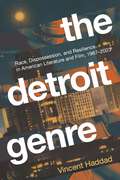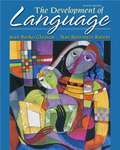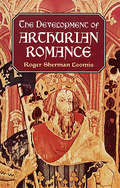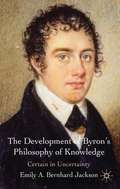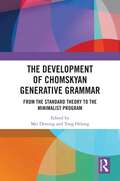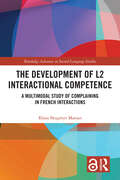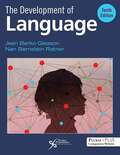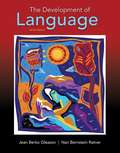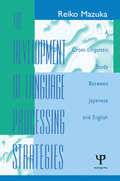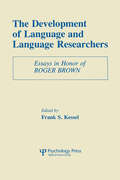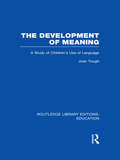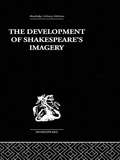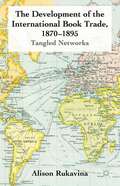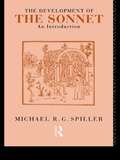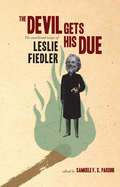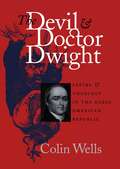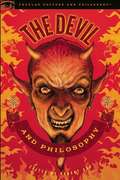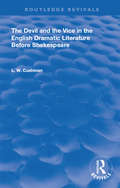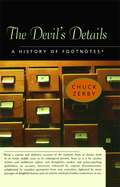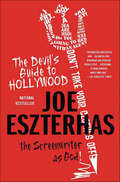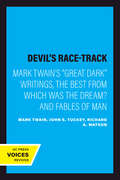- Table View
- List View
The Detective Story: An Introduction to the Whodunit
by Saul SchwartzAn American writer, Edgar Allan Poe, created the world's first detective story. Before Poe, there had been puzzle stories, suspense and murder tales, and adventure and horror narratives--but, clearly, as one critic put it, "... there could be no detective stories until there were detectives." This new form of police activity began to evolve at the beginning of the nineteenth century.
The Detective as Historian: History and Art in Historical Crime Fiction
by Ray B. Browne Lawrence A. KreiserReaders of detective stories are turning more toward historical crime fiction to learn both what everyday life was like in past societies and how society coped with those who broke the laws and restrictions of the times. The crime fiction treated here ranges from ancient Egypt through classical Greece and Rome; from medieval and renaissance China and Europe through nineteenth-century England and America. Topics include: Ellis Peter'sBrother Cadfael; Umberto Eco'sName of the Rose; Susanna Gregory'sDoctor Matthew Bartholomew; Peter Heck's Mark Twain as detective; Anne Perry and her Victorian-era world; Caleb Carr's works; and Elizabeth Peter's Egyptologist-adventurer tales.
The Detective's Companion in Crime Fiction: A Study in Sidekicks (Crime Files)
by Lucy Andrew Samuel SaundersThis book aims to establish the position of the sidekick character in the crime and detective fiction literary genres. It re-evaluates the traditional view that the sidekick character in these genres is often overlooked as having a small, generic or singular role—either to act as the foil to the detective in order to accentuate their own abilities at solving crimes, or else to simply tell the story to the reader. Instead, essays in the collection explore the representations and functions of the detective’s sidekick across a range of forms and subgenres of crime fiction. By incorporating forms such as children’s detective fiction, comics and graphic novels and film and television alongside the more traditional fare of novels and short stories, this book aims to break down the boundaries that sometimes exist between these forms, using the sidekick as a defining thread to link them together into a wider conceptual argument that covers a broad range of crime narratives.
The Detroit Genre: Race, Dispossession, and Resilience in American Literature and Film, 1967-2023
by Vincent HaddadDetroit has an essential relationship to genre in American literature and popular culture. The contemporary formations of the suburban sitcom, the post-apocalyptic genre, the sci-fi dystopia, crime fiction, the superhero genre, and contemporary horror would not exist in the way they do today without the aesthetic material and racial history of Detroit. When DC Comics wanted to compete with Marvel and market “socially relevant” comics, especially ones dealing with issues of race, they swapped Gotham and Metropolis for Detroit. What about vampires concerned with de-industrialization, heritage conservation, and impending water wars? Must be Detroit. A story about a half-man, half-robot wrestling with what it means to be human by fighting crime? Improbably, Detroit has two. Author Vincent Haddad’s The Detroit Genre provides the first comprehensive literary and cultural investigation of the representations of Detroit in popular and literary culture. The book first establishes the concept of the “Detroit genre” that emerged in late 1960s and traces the tropes of this white-centric narrative genre in popular culture, touching on key texts including Blue Collar, Robocop, The Crow, It Follows, and Barbarian. The second part shows how Black writers, including Alice Randall, adrienne maree brown, Stephen Mack Jones, and Angela Flournoy, reclaimed and revised the Detroit genre by un-fixing Detroit narratives of dispossession, criminality, and industrial and social failure through formal experimentations on genre itself. Where Detroit has typically been painted in the news as one of three things—the center of the automotive industry; crime-ridden and in ruins; or as a “blank canvas” with limitless potential of entrepreneurship—Vincent Haddad shows that the Detroit genre in literature and film can be far more powerful than news media in narrating Black dispossession as a pragmatic, even liberal consensus. The texts studied here condition forgetfulness about Detroit’s history or expose it to a full reckoning, direct attention toward or away from the city’s agents of injustice, fetishize resilience or model resistance, and foreclose or imagine a future of Black liberation. Appealing to scholars of popular literature, media, race, and American studies, The Detroit Genre is an accessible and engaging study of the city’s influence on a wide array of genres in pop culture.
The Development Of Language (8th Edition)
by Jean Berko Gleason Nan Bernstein RatnerCombining the contributions of experts and highly-respected researchers, the eighth edition of Language Development offers a definitive exploration of language acquisition and development from infancy through adulthood. Taking a multi-disciplinary approach, it examines what we know about language development--addressing communication development in infancy, phonological development, semantic development, morphology and syntax. Broadening the scope of study, it puts language development into larger biological, social and cultural contexts, while investigating individual differences, atypical development, literacy and even language development in adults. This edition includes more on cross-linguistic language acquisition (emphasizing Spanish), new research on the nature and treatment of language disorders in children, and new perspectives on the impact of culture on language development and variation.
The Development of Arthurian Romance
by Roger Sherman LoomisStimulating and masterly study examines the evolution of the great mass of fiction surrounding the Arthurian legend in Western literature -- from Geoffrey of Monmouth's History of the Kings of Britain and the collection of Welsh tales known as The Mabinogion, to Chrétien de Troyes' Arthurian stories, the Parzival of Wolfram von Eschenbach, and such English masterpieces as Sir Gawain and the Green Knight and Le Morte d'Arthur. Painstakingly researched and brimming with scholarly insight, this highly readable and entertaining work will be a favorite with general audiences as well as scholars and students of the Arthurian legend.
The Development of Byron's Philosophy of Knowledge
by Emily A. Bernhard JacksonTaking a fresh approach to Byron, this book argues that he should be understood as a poet whose major works develop a carefully reasoned philosophy. Situating him with reference to the thought of the period, it argues for Byron as an active thinker, whose final philosophical stance - reader-centred scepticism - has extensive practical implications.
The Development of Chomskyan Generative Grammar: From the Standard Theory to the Minimalist Program
by Mei Deming Tong HelongThis book explores the major theories of generative grammar from a historical perspective, providing an overview of the evolution of this linguistic framework.Generative grammar is widely recognized for its major contributions to the study of theoretical linguistics in the twentieth century and has had a profound impact on the fields of linguistics, psychology, computer science, and cognitive science. This book consists of eight chapters that trace the development of generative grammar from its beginnings to its current focus on minimalism. The first chapter outlines the major stages of generative grammar, namely Classical Theory, Standard Theory, Extended Standard Theory, Revised Extended Standard Theory, Government and Binding Theory, and the Minimalist Program. The second chapter reviews the development of the C‑command relation and illustrates its use in syntactic analysis. Each of the following six chapters focuses on a specific area of generative grammar, including phrase structure, movement, Case, argument structure, binding, and raising and control.The volume will be an invaluable resource for researchers, teachers, and students in the fields of generative grammar, syntax, formal linguistics, and the social and cognitive sciences.
The Development of L2 Interactional Competence: A Multimodal Study of Complaining in French Interactions (Routledge Advances in Second Language Studies)
by Klara Skogmyr MarianThis book presents unique insights into the development of L2 interactional competence through the lens of complaining, demonstrating how a closer study of complaining as a social activity can enhance our understanding of certain aspects of language learning with implications for future L2 research. The volume employs a multimodal, longitudinal conversation analytic (CA) approach in its analysis of data from video-recorded interactions of several elementary and advanced L2 speakers of French as they build their interactional competence, understood as the ability to accomplish social actions and activities in the L2 in context-dependent and recipient-designed ways. Skogmyr Marian calls attention to three key dimensions of complaining in these conversations – its structural organization, the interactional resources people use when they complain, and how speakers’ shared interactional histories and changing social relationships affect complaint practices. The volume underscores the fundamentally multimodal, socially situated, and co-constructed nature of L2 interactional competence and the socialization processes involved in its development, indicating paths for new work on interactional competence and L2 research more broadly. This book will be of appeal to students and scholars interested in second language acquisition, social interaction, and applied linguistics. The Open Access version of this book, available at www.taylorfrancis.com, has been made available under a Creative Commons Attribution 4.0 license.
The Development of Language
by Jean Berko Gleason Nan Bernstein RatnerThis classic text now in its tenth edition and now available from Plural Publishing,The Development of Languagecontinues its focus on language acquisition in an unbiased, authoritative, and comprehensive way. Written by leading experts known for their research in the areas they discuss, this book has a multidisciplinary approach, and demonstrates the relevance of typical language development to speech-language pathologists, educators, clinicians, and those in other professions. Topics include the roots of language learning in infancy, phonology, syntax/grammar, word learning, bilingualism, pragmatics, literacy, atypical language development, and more. This book provides the reader with an authoritative text that includes important and useful concepts and research findings. Emphasis is placed on language development in children who are learning languages other than, or in addition to, English, as well as children with risk factors for language delay or disorder. The text leads the reader through every stage of development—the early months before children begin to speak, the preschool and school years, and adolescence as children achieve mastery of adult-like language skills.
The Development of Language
by Jean Gleason Nan RatnerFeaturing a multi-disciplinary approach–and chapters written by outstanding scholars known for their expertise in the areas they discuss–The Development of Language focuses on language acquisition throughout the lifespan, with new coverage of linguistic achievements in the first year of life and through the middle school years. It examines what we know about language development using biological, social, and cultural contexts, while also investigating individual differences, atypical development, literacy, and language development in adults. Each chapter is written by world-renowned scholars and cutting-edge researchers, and each chapter provides a helpful summary, list of key words, a comprehensive text glossary explaining each term, and extensive links to video resources that help bring the concepts to clarity, through examples of child communication behaviors, insights into how research into child language is conducted, and first person interviews with influential researchers in the field. <P><P>The new edition emphasizes language development in children who are learning languages other than English or are bilingual and includes new information about children with risk factors for language delay or disorder. Within each topical area, such as speech production, vocabulary, syntax, pragmatics, and literacy, the authors integrate discussion of potential problems or differences in how children learn the various aspects of language. Cultural influences that lead to group and individual variation in children’s language environments and profiles of language development are addressed throughout. The Enhanced Pearson eText features embedded videos.
The Development of Language Processing Strategies: A Cross-linguistic Study Between Japanese and English
by Reiko MazukaEver since the notion of explanatory adequacy was promoted by Chomsky in his 1965 Aspects, linguists and psycholinguists have been in pursuit of a psychologically valid theory of grammar. To be explanatorily adequate, a theory of grammar can not only describe the general characteristics of a language but can also account for the underlying psychological processes of acquiring and processing that language. To be considered psychologically valid, a grammar must be learnable by ordinary children (the problem of acquisition) and must generate sentences that are parsable by ordinary people (the problem of processing). Ultimately, the fields of language acquisition and processing are concerned with the same goal: to build a theory that accounts for grammar as it is acquired by children; accessed in comprehension and production of speech; and represented within the human mind. Unfortunately, these two fields developed independently and have rarely been well-informed about each other's concerns. Both have experienced past difficulties as a result. Recently, new models have been developed with full consideration to cross-linguistic diversity. Gone are many of the basic assumptions of conventional models, and in their place a variety of innovative and more flexible assumptions have emerged. However, in their attempt to address cross-linguistic issues, these processing models have yet to fully address the developmental challenge: How can a child without a stable grammar process language and still manage to acquire new grammar? This book attempts to develop a model of language processing that addresses both cross-linguistic and developmental challenges. It proposes to link the setting of a basic configurational parameter during language acquisition to the different organization of processing strategies in left- and right-branching languages. Based primarily on Mazuka's doctoral dissertation, this volume incorporates various responses to the original proposal as well as the author's responses to the comments.
The Development of Language and Language Researchers: Essays in Honor of Roger Brown
by Frank S. KesselFirst published in 1988. This is a collection of essays that were presented at or generated afterwards at a meeting on language acquisition Society Development in April 1981: a symposium on “The Development of Language and Language Researchers: Whatever Happened to Linguistic Theory?” in Boston.
The Development of Meaning: A Study of Children's Use of Language (Routledge Library Editions: Education)
by Joan ToughThis book investigates children's use of language and considers its implications for children's learning at home and at school. The author compares the language used by children from different social environments at the ages of three, five and seven and considers the different approaches that children take towards their school experiences. The book discusses the problems of studying children's use and development of language and in doing so looks at the implications of a number of theories. It uses theory in order to establish a useful framework which will help teachers to become aware of the skills that children have established in using language when they come to school.
The Development of Shakespeare's Imagery (University Paperbacks Ser.)
by Wolfgang ClemenFirst published in 1951. The edition reprints the second, updated, edition, of 1977. When first published this book quickly established itself as the standard survey of Shakespeare's imagery considered as an integral part of the development of Shakespeare's dramatic art. By illustrating, through the use of examples the progressive stages of Shakespeare's use of imagery, and in relating it to the structure, style and subject matter of the plays, the book throws new light on the dramatist's creative genius. The second edition includes a new preface and an up-to-date bibliography.
The Development of the International Book Trade, 1870–1895
by By Alison RukavinaAn international trade emerged between 1870-1895 that incorporated the circulation of books among countries worldwide. A history of the social network and select agents who sold and distributed books overseas, this study demonstrates agents increasingly thought of the world as a negotiable, connected system and books as transnational commodities.
The Development of the Sonnet: An Introduction
by Michael R. SpillerFirst published in 1992. Routledge is an imprint of Taylor & Francis, an informa company.
The Devil Gets His Due: The Uncollected Essays of Leslie Fiedler
by Leslie FiedlerDespite his often-unacknowledged influence, academics, intellectuals, and the general audience in America and abroad still read Leslie Fiedler’s work and draw on its concepts. He inspired both reverence (Leonard Cohen penned: "leaning over the American moonlight / like the shyest gargoyle / who will not become angry or old") and rage (Saul Bellow called him "the worst fucking thing that ever happened to American literature"). The essays in The Devil Gets His Due will reacquaint readers with the depth and breadth of Fiedler’s achievements. Tackling subjects ranging wildly from Dante, Ezra Pound, and Mary McCarthy to Rambo, Iwo Jima, and Jerry Lewis, these writings showcase Fiedler’s pioneering of an egalitarian canon that encompassed both "high" and popular literature, cinema, and history. As such, they show a powerful mind critiquing whole aspects of a culture and uncovering lessons therein that remain timely today. A lengthy introduction by Professor Samuele F. S. Pardini offers both context and history, with an in-depth profile of Fiedler and his career as both a literary critic and a public intellectual.
The Devil and Doctor Dwight
by Colin WellsAt the close of the eighteenth century, Timothy Dwight--poet, clergyman, and, later, president of Yale College--waged a literary and intellectual war against the forces of "infidelity." The Devil and Doctor Dwight reexamines this episode by focusing on The Triumph of Infidelity (1788), the verse satire that launched Dwight's campaign and, Colin Wells argues, the key to recovering the deeper meaning of the threat of infidelity in the early years of the American Republic. The book also features the first modern, annotated edition of this important but long-overlooked poem.Modeled after Alexander Pope's satiric masterpiece, the Dunciad, Dwight's poem took aim at a number of his contemporaries, but its principal target was Congregationalist Charles Chauncy, author of a controversial treatise asserting "the salvation of all men." To Dwight's mind, a belief in universal salvation issued from the same naive faith in innate human virtue and inevitable progress that governed all forms of Enlightenment thought, political as well as religious. Indeed, in subsequent works he traced with increasing dismay a shift in the idea of universal salvation from a theological doctrine to a political belief and symbol of American national identity. In this light, Dwight's campaign against infidelity must also be seen as an early and prescient critique of the ideological underpinnings of Jeffersonian democracy.
The Devil and Philosophy
by Robert ArpIn The Devil and Philosophy, 34 philosophers explore questions about one of the most recognizable and influential characters (villains?) of all time. From Roman Polanski's The Ninth Gate to J.R.R. Tolkien's The Silmarillion to Bram Stoker's Dracula to Darth Vader to Al Pacino's iconic performance in The Devil's Advocate, this book demonstrates that a little devil goes a long way. From humorous appearances, as in Kevin Smith's film Dogma and Chuck Palahniuk's novels Damned and its sequel Doomed, to more villanous appearances, such as Gabriel Byrne's cold outing as Satan in End of Days, The Devil in Philosophy proves that the Devil comes in many forms.Through the lenses of Jung, Kant, Kundera, Balkan, Plato, Bradwardine, Aristotle, Hume, Blackburn, Descartes, Lavey, Thoreau, and Aquinas, The Devil and Philosophy take a philosophical look at one of time's greatest characters. Are there any good arguments for the actual existence of the Devil? Does demonic evil thrive in Gotham City? Can humans really be accountable for all evil? Which truths about the Devil are actual facts? Is Milton correct, in that the Devil believes he is doing good?
The Devil and the Vice in the English Dramatic Literature Before Shakespeare (Routledge Revivals)
by L. W. CushmanOriginally published in 1900, this book was the first investigation of the devil and the Vice as dramatic figures, and a study of these figures led to a new view of the subject: it is, in brief, that the appearance of the devil in the non-dramatic as well as in the dramatic literature is limited to a definite range. As a dramatic figure the devil falls more and more into the background and the Vice is distinct in origin and function from the devil.
The Devil's Details
by Chuck ZerbyFootnotes have not had it easy. Their dominance of eighteenth- and nineteenth- century literature and scholarship was both hard-won -- following many years of struggle -- and doomed, as it led to belittlement in the twentieth century. InThe Devil's Details,Chuck Zerby playfully explores footnotes' long and illustrious history and makes a clarion call to save them from the new world of the Internet and hypertext. In a story that boasts a marvelous plot and a rogues' gallery of players, Zerby examines traditional footnotes and their less-buttoned-down incarnations, as when used by pornographers. Yes,The Devil's Detailsis full of surprises: Zerby hunts down the first bona fide fully functioning footnote; unearths a multivolume history of Northumberland County, England, that uses one volume for a single footnote; and uncovers a murder plot. He even explains why footnotes are like blind dates. Carefully researched and highly opinionated,The Devil's Detailsaffirms that delight in reading can come from unexpected places.
The Devil's Guide to Hollywood: The Screenwriter as God!
by Joe EszterhasIn The Devil's Guide to Hollywood, bestselling author and legendary bad-boy screenwriter Joe Eszterhas tells everything he knows about the industry, its players and screenwriting itself—from the first blank sheet of paper in the Olivetti to the size of the credit on the one-sheet. "There's just one hunk of funny anecdote after another, quotes from everyone who ever mattered in the movie biz, and the thing is jam-packed with screenwriterly advice. Plus it's hilariously funny, ribald, sexy and brilliant."—Liz SmithOften practical and always entertaining, The Devil's Guide to Hollywood distills everything one of Hollywood's most accomplished screenwriters knows about the business, from writing advice to negotiation tricks, from the wisdom of past players to the feuds of current ones. Eszterhas has selected his personal pantheon of the most loved and loathed players in the business and treats the reader to a treasure trove of stories, quotes and wisdom from those luminaries, who include William Goldman (loathes) and Zsa Zsa Gabor (loves). The Devil's Guide to Hollywood could only have been written by someone who loves the business as much as Eszterhas does—but who also has its number."Eszterhas delivers a dishy, catty mix of reminiscences and Hollywood trivia…his forte is skewering sycophants and phonies in this opinionated showcase of the underside of Hollywood life."—Publishers Weekly
The Devil's Race-Track: Mark Twain's "Great Dark" Writings, The Best from Which Was the Dream? and Fables of Man
by Mark TwainMark Twain explores the darker side of life in these lesser-known later writings dealing with personal tragedies, nightmarish world events, and a doubtful cosmic order. He views his own situation as that of a ship trapped in a fearsome Bermuda Triangle-like region, the Devil's Race-Track. He sees history as a treadmill of endlessly and monotonously repeated events. And he conceives of a universal food chain, a vast round of devourers who in their turn become victims, humankind and God included. The tone of these writings is lightened considerably by Mark Twain's sagely ironic humor and his warmth, which together balance his tough-mindedness. And even when he shows the human race caught in some vicious circle, he may be seen courageously seeking a way out and at times believing he has found it.
The Devils and Canon Barham: Ten Essays on Poets, Novelists and Monsters
by Leon Edel Edmund WilsonThe book takes its title from the scene of Lenin's arrival from Germany in April 1917, ready to take over the leadership of the Russian Revolution and in doing so bring to a climax the political and intellectual movements which are the subject of this study.

